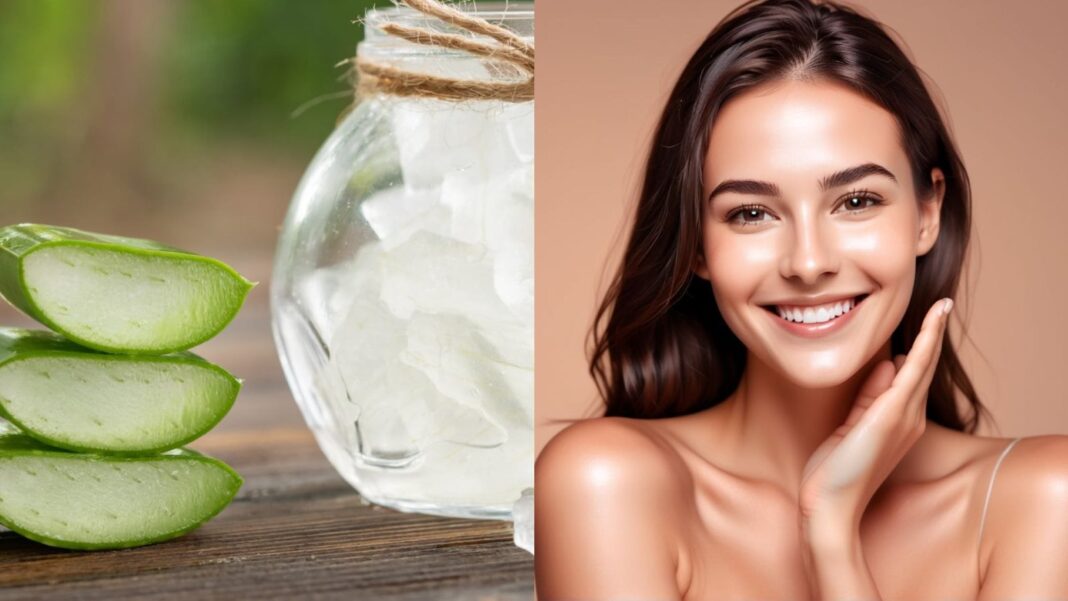Say goodbye to dull, dry skin by using aloe vera face masks. These keep your skin moisturised, giving them a healthier glow.
When it comes to glowing skin, hundreds of products and hacks are available to give you the skin of your dreams. But nothing can beat the results of using natural ingredients to get glowing skin! And by natural ingredients, we mean ingredients that you can easily find and can prepare a DIY recipe at your home to use on your skin—having said that using an aloe vera face mask gives you a radiant and glowing appearance. Its clear gel is packed with vitamins, minerals, and antioxidants, that offer a natural remedy for various skin concerns. If you are curious about including an aloe vera face mask in your regular skincare routine, know how you can use it.
Aloe vera face mask for glowing skin: Does it help?
- This plant contains vitamins, minerals, antioxidants, and enzymes, using an aloe vera face mask can help you achieve beautiful skin. These nutrients work together to moisturise, nourish, and protect the skin from free oxidative stress and harmful UV rays, as per a study published in the Yemen Journal of Medicine.
- Plus, aloe vera’s moisturising features plump the skin and reduce wrinkles and fine lines, as found in a study published in the Journal of Annals Dermatology. Its antioxidant composition fights free radicals, avoiding premature ageing.
- Additionally, aloe vera’s anti-inflammatory qualities can relieve irritated skin and minimise redness, resulting in a more even skin tone, according to a study published in the journal Molecules.

10 DIY aloe vera face masks for a healthy glow
Here are some easy aloe vera face masks to incorporate into your skincare routine.
1. Honey and aloe vera face mask: Mix 2 tablespoons of aloe vera gel with 1 tablespoon of honey. Apply to your face for 20 minutes and rinse off with water.
2. Cucumber and aloe vera face mask: Blend half a cucumber and mix it with 2 tablespoons of aloe vera gel. Apply to your face for 15 minutes and wash off with water.
3. Lemon and aloe vera face mask: Mix 2 tablespoons of aloe vera gel with 1 teaspoon of lemon juice. Apply to your face for 15 minutes and rinse off with water.
4. Turmeric and aloe vera face mask: Mix 2 tablespoons of aloe vera gel with 1/2 teaspoon of turmeric powder. Apply to your face for 15 minutes and rinse off with running water.
5. Yoghurt and aloe vera face mask: Mix 2 tablespoons of aloe vera gel with 1 tablespoon of yoghurt. Apply to your face for 15 minutes and wash off with water.
6. Green tea and aloe vera face mask: Brew a cup of green tea and let it cool. Mix 2 tablespoons of aloe vera gel with 1 tablespoon of green tea. Apply to your face for 15 minutes and rinse off with water.

7. Oatmeal and aloe vera face mask: Cook 1/4 cup of oatmeal according to package directions. Let it cool and mix it with 2 tablespoons of aloe vera gel. Apply to your face for 15 minutes and wash off.
8. Banana and aloe vera face mask: Mash half a banana and mix it with 2 tablespoons of aloe vera gel. Apply to your face for 15 minutes and rinse off.
9. Avocado and aloe vera face mask: Mash half an avocado and mix it with 2 tablespoons of aloe vera gel. Apply to your face for 15 minutes and rinse off.
10. Rosewater and aloe vera face mask: Mix 2 tablespoons of aloe vera gel with 1 tablespoon of rosewater. Apply to your face for 15 minutes and rinse off.
Side effects of using aloe vera face masks
While aloe vera is generally considered safe for topical use, some people may experience side effects from aloe vera face masks. These can include:
- Some people may be allergic to aloe vera, leading to contact dermatitis with symptoms like redness, itching, burning, or a rash.
- Aloe vera can irritate sensitive skin, causing redness, stinging, or a burning sensation.
- Overuse of aloe vera can strip the skin of its natural oils, leading to dryness or a tight feeling.
- Aloe vera may make the skin more sensitive to sunlight, increasing the risk of sunburn.
Things to keep in mind!
- Before applying an aloe vera face mask to your entire face, perform a patch test on a small area of skin to check for any adverse reactions.
- Use aloe vera face masks in moderation, typically once or twice a week, to avoid potential dryness or irritation.
- If using an aloe vera face mask during the day, always follow up with sunscreen to protect your skin from sun damage.
If you experience any side effects after using an aloe vera face mask, discontinue use and consult a dermatologist if symptoms persist.
Related FAQs
How often can I use an aloe vera face mask?
Generally, using an aloe vera mask 1-2 times a week is recommended. However, it depends on your skin type and sensitivity. If you have sensitive skin, start with once a week.
Can I use aloe vera gel directly from the plant on my face?
Yes, you can! Just make sure to wash the leaf thoroughly and extract the gel carefully.
Disclaimer: At Health Shots, we are committed to providing accurate, reliable, and authentic information to support your health and well-being. However, the content on this website is intended solely for informational purposes and should not be considered a substitute for professional medical advice, diagnosis, or treatment. Always consult a qualified healthcare provider for personalised advice regarding your specific medical condition or concerns.







